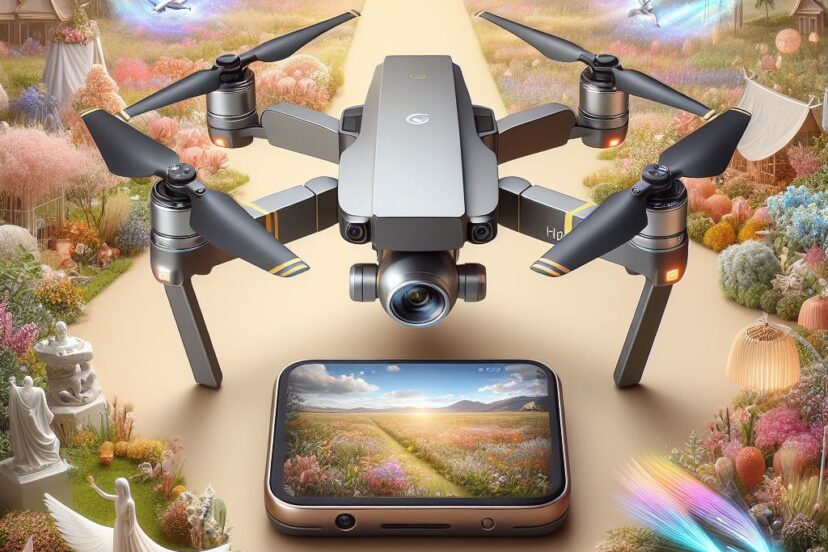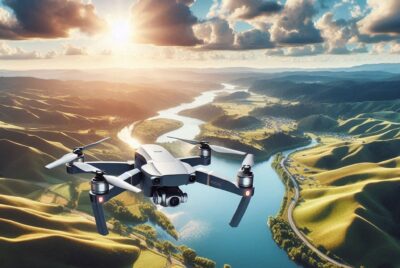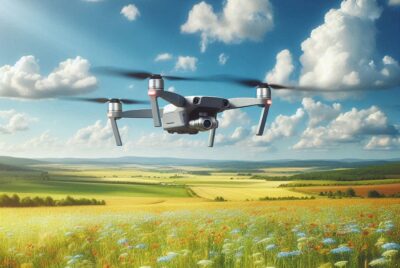Top Drones for Videography: Aerial Excellence
*We may earn a commission for purchases made using our links. Please see our disclosure to learn more.
Top Drones for Videography: Ultimate Picks for Filmmakers
Videography has transformed with the advent of drones, allowing filmmakers to capture stunning aerial footage that was once reserved for high-budget productions with access to helicopters or planes. Drones for videography bring dynamic perspectives to visual storytelling, making them powerful tools for professionals and enthusiasts alike. These flying cameras can navigate through tight spaces, soar to great heights, and hover to provide stable video footage, incorporating breathtaking views into any film project.
As with any specialized equipment, choosing the right drone for videography hinges on several critical factors. Camera quality is paramount, as drones need to deliver high-resolution video to meet today’s standards for sharpness and detail. Stabilization technology, such as a gimbal, is also vital, ensuring that footage remains smooth despite the drone’s movements. Flight time and range, overall weight, and ease of control are additional attributes that can greatly influence the user experience and final video quality.
When in the market for a videography drone, potential buyers should consider not only the specs but also the drone’s reliability and the manufacturer’s customer support. Regulations surrounding drone flights, which differ by region, must also be taken into account to ensure responsible piloting and legal compliance. My thorough selection process included considering these factors, as well as user reviews and my own experience as a videography enthusiast.
Through rigorous testing and comparison, I’ve pinpointed the top drones that excel in providing high-quality video footage and a superior flying experience. Each model has been evaluated for its performance, camera capabilities, stability, and ease of use, making it easier for you to find the perfect drone to enhance your videography projects.
Top Drones for Videography
In my experience, finding the perfect drone for videography hinges on balancing camera quality, flight stability, and ease of use. My selection reflects the experiences of professionals and hobbyists alike, ensuring you access the latest technology to capture stunning aerial footage. Whether you’re filming for commercial projects or personal ventures, the drones on this list cater to a wide range of needs and skill levels.
RADCLO 1080P Mini Drone
I recommend this RADCLO mini drone for its ease of use and stable flying capabilities, perfect for both beginners and experienced users looking for a versatile videography tool.
Pros
- Wide-angle 1080P adjustable camera offers stunning video and photo quality
- User-friendly features such as the Altitude Hold and one-key take-off/landing
- Generous accessory pack including spare batteries and carrying case
Cons
- Larger body size may not be as portable as other mini drones
- May be difficult to control in windy conditions
- Some users may find the flight time limited despite having two batteries
Having had the opportunity to put the RADCLO 1080P Mini Drone through its paces, I was genuinely impressed by the quality of footage I could capture. The 90° adjustable wide-angle lens provided expansive views that enhanced my videography projects.
The flight stability of this drone was noteworthy. Even as a relatively experienced flyer, I appreciated the Altitude Hold function that allowed me to focus on capturing smooth footage without worrying about fluctuating altitudes, which can often be a challenge with entry-level drones.
What added to my positive experience was the thoughtfulness behind the accessories included. Having two 800mAh batteries meant I could film for more extended periods, which was crucial during my outdoor shoots. The carrying case simplified transportation, protecting the drone as I moved between locations.
In conclusion, the RADCLO 1080P Mini Drone proved itself to be a reliable gadget for videography, bringing together user-friendly controls and appealing additional features that support capturing quality footage. While its size may deter those looking for ultra-portability, and flying in breezy conditions could be a challenge, the pros significantly outweigh the cons, making it a worthy investment for drone enthusiasts keen on videography.
Top Drones for Videography: Bwine GPS Drone
If you’re seeking a reliable videography drone that offers professional-grade features without breaking the bank, the Bwine GPS Drone is a solid investment for your aerial footage collection.
Pros
- Exceptional flight time, easing the pressure of rushed shoots
- Stable footage with 3-axis gimbal, even in windy conditions
- Automated return-to-home function adds a layer of safety
Cons
- Requires patience for a full charge, so plan ahead
- The app’s interface might take some getting used to
- Bulky to transport despite the carrying case
Flying the Bwine GPS Drone gave me a real sense of its capabilities in the field. Its 4K camera captured crystal-clear footage during a twilight shoot – the details were sharp even in lower light. The three-axis gimbal kept the video steady, which was noticeable when panning across a stunning landscape. Operation felt intuitive after a few flights, although I had to familiarize myself myself with the different modes.
The 75-minute flight time with all batteries charged is a game-changer for longer shoots. I didn’t have to worry about running out of power mid-flight, which allowed me to focus on capturing the perfect shot. Swapping out batteries was straightforward, keeping the downtime to a minimum.
One of the features I appreciated the most was the automatic return-to-home when the battery was low or if the drone lost signal. It’s reassuring to know your equipment will come back safely. However, carrying the drone to locations took a bit of effort due to its bulkiness, and the long charging times meant I had to plan my shoots well in advance.
Overall, the advanced functionalities like follow-me mode and 6-level wind resistance solidify the Bwine GPS Drone as a strong contender for both enthusiastic hobbyists and seasoned professionals looking to capture stunning aerial views.
Top Drones for Videography: TENSSENX Q7
I recommend the TENSSENX Q7 for its user-friendly features that cater to both beginners and seasoned flyers, making for a fulfilling videography experience.
Pros
- The 4K UHD Camera with image stabilization captures crisp, stable footage.
- GPS-assisted flight adds multiple smart features for an enhanced experience.
- The package includes two batteries for an extended flight time of up to 60 minutes.
Cons
- Beginners may find the array of high-tech features initially overwhelming.
- The drone relies heavily on a strong GPS signal for optimal performance.
- Despite the carrying case, the design might still be bulky for those seeking an ultra-portable option.
After sending the TENSSENX Q7 into the sky, I was genuinely impressed by the quality of the footage. The image stabilization is robust, keeping the video smooth even when I encountered a gust of wind. It’s the kind of footage you’re proud to share or even use for professional purposes.
Setting a path for the drone via GPS felt futuristic. It followed my predetermined route flawlessly, which is perfect for capturing those sweeping landscape shots or following the action without manual piloting. The return home function triggered by a low battery, weak signal, or a press of a button adds peace of mind, especially when exploring new terrains.
The two included batteries were lifesavers during my day out in the field. Just when I thought the first battery was depleted, I switched it out and continued my journey. I appreciated the thoughtful inclusion of a carrying case; it’s a small touch, but one that simplifies transportation and storage.
Navigating the controls took some time to master, but the intuitive LED remote control provided necessary information right at my fingertips. The drone’s performance didn’t disappoint, either—the brushless motors operated quietly and offered a substantial flight time, reducing the distractions in a serene setting.
If you’re venturing into the realm of drone videography, the TENSSENX Q7 delivers a blend of quality, control, and smart features. Whether you’re capturing a quiet sunrise or a dynamic street scene, this drone has you covered.
Potensic ATOM Fly More Combo
I believe the Potensic ATOM Fly More Combo is a solid investment for videography enthusiasts looking for a lightweight yet capable drone with impressive flight time.
Pros
- No FAA registration required due to its weight
- Stable 4K footage with 3-axis gimbal even in windy conditions
- Extended flight time with quick charging batteries
Cons
- Connectivity range may be an issue in dense areas
- Limited payload capacity due to its size
- Beginners may take time to fully utilize all features
Flying the Potensic ATOM was a breeze, and its compact size made it extremely portable. I didn’t need to worry about FAA registration, which is a huge plus for anyone who wants to avoid that hassle. Tucking it into my bag, I found it to be the perfect companion for impromptu videography sessions.
The 4K camera, supported by a 3-axis gimbal, provided me with marvelously steady footage. High winds weren’t much of a challenge for the ATOM, ensuring I consistently captured smooth video. This gimbal’s reliability encourages creativity and shooting from various perspectives without compromising on the quality.
Battery life can be a bottleneck in many drones, but not with this Fly More Combo. It comes with three batteries, and their fast charging capability kept me in the air for longer periods. I appreciated the extra time to perfect my shots without constantly worrying about power levels.
However, while trekking through some dense urban environments, I noticed the 6KM connectivity range could be limiting. Drone pilots in more built-up areas should be aware of this potential challenge. Additionally, the lightweight nature of the ATOM means it won’t carry additional payloads, which could be a concern for those looking to attach extra equipment.
Lastly, as intuitive as the Potensic ATOM is, beginners might require some extra time to master all its features, especially the creative video functions like Visual Tracking and QuickShots. For me, the learning curve was a journey worth the enhanced capability and the dynamic footage I could capture.
Holy Stone HS175D
I believe this drone is ideal for those venturing into aerial photography without breaking the bank.
Pros
- Captures crisp, clear 4K footage with ease
- GPS feature brings peace of mind with auto return
- Extended flight time lets you enjoy longer sessions
Cons
- Learning to navigate the controls may take some time
- It struggles in windy conditions
- The additional features can overwhelm beginners
I’ve recently had the pleasure of flying the Holy Stone HS175D, and I must say, it’s a solid entry into the world of aerial videography. The camera quality didn’t disappoint; the 4K resolution provided stunning clarity that would make any amateur filmmaker proud. Personally, I appreciated how the adjustable angles gave me creative control over my shots.
Being someone who lives in fear of losing my tech toys, I was particularly fond of the GPS auto return function. It kicked in perfectly when I pushed the drone a bit too far from its home base. No heart-dropping moments of watching my investment disappear over the horizon.
Truth be told, despite its beginner-friendly claim, there was a slight learning curve to master the controls. My first flight session involved a bit of trial and error, but nothing too discouraging. It’s worth mentioning, while the drone handled itself well in a gentle breeze, it did become less responsive when the gusts picked up.
In sum, the Holy Stone HS175D felt like a reliable companion for those looking to expand their videography skills from the ground to the skies. The battery life certainly allowed me to practice without the constant worry of recharging, which I consider a big plus. For newcomers to drone piloting, take your time to get acquainted with all the features, and you’ll be rewarded with spectacular views and impressive footage.
Buying Guide for Top Drones for Videography
Understanding Your Needs
Before purchasing a drone for videography, I consider the kind of footage I need. Key factors include environment (indoor or outdoor), type of shots (landscape, action, etc.), and the final video resolution required.
Camera Quality
The camera quality is paramount for videography drones. I look for drones with a minimum of 1080p resolution. For higher quality work, 4K is the standard. Frame rate is also important, with 30fps being satisfactory for most work, but 60fps or higher being ideal for slow-motion footage.
Flight Time
Flight time indicates how long a drone can stay airborne on a single charge. I seek drones with longer flight times to avoid frequent landings and battery changes. A minimum of 20 minutes is generally suitable, but for extended shoots, I may opt for drones offering 30 minutes or more.
Stability and Control
A gimbal stabilizes the camera during flight, ensuring smooth footage. I ensure the drone has a reliable gimbal system. Additionally, I check for responsive and intuitive controls, as this directly impacts the ease of capturing desired shots.
Budget
| Feature | Essential | Nice-to-Have | Not Necessary |
| Resolution | 1080p | 4K | 8K |
| Flight Time | 20+ mins | 30+ mins | 50+ mins |
| Gimbal | 3-axis | 3-axis with advanced features | Fixed camera |
| Control | Responsive controls | Automated flight modes | Voice control |
I consider my budget and prioritize the features that are more crucial to my videography needs, balancing between essentials and desirable extras.
FAQs for Top Drones for Videography
In this section, I’ll address common queries regarding drones used in videography, focusing on equipment suited for various levels of expertise and budget considerations.
1. What are the most recommended drones for cinematic video production?
The DJI Inspire 2 with Zenmuse X7 camera is highly praised for its advanced features and professional image quality. Another favorite is the DJI Mavic Air 2S, known for its impressive camera and intelligent shooting modes suitable for cinematic footage.
2. What features should I look for in a drone if I’m interested in professional photography and videography?
Look for drones that offer a 1-inch or larger sensor, shoot in RAW or D-Log for advanced post-production, feature mechanical shutters to reduce rolling shutter effect, and provide a high dynamic range. A drone with 4K or higher resolution and strong gimbal stabilization is also crucial for crisp, smooth footage.
3. Which drones are considered the best for both beginners and experts in aerial filmmaking?
The DJI Mavic series, particularly the Mavic Air 2 and Mavic 2 Pro, are versatile drones suitable for both novices and seasoned professionals due to their user-friendliness and exceptional image quality. The Autel Robotics EVO II offers robust features accessible for all skill levels as well.
4. What are the highest-rated drones for capturing 4K video without breaking the bank?
The DJI Mini 2 is an excellent budget-friendly option with 4K video capabilities, while the DJI Mini SE presents an even more affordable alternative with good video quality. Both are highly rated given their cost-to-performance ratio.
5. Can you suggest any compact mini drones that offer professional-grade 4K video capabilities?
I recommend the DJI Mini 2 for its ultra-portable design and 4K video recording. The Autel EVO Nano+ is another compact choice that doesn’t compromise on a 4K camera for professional-level videography.









